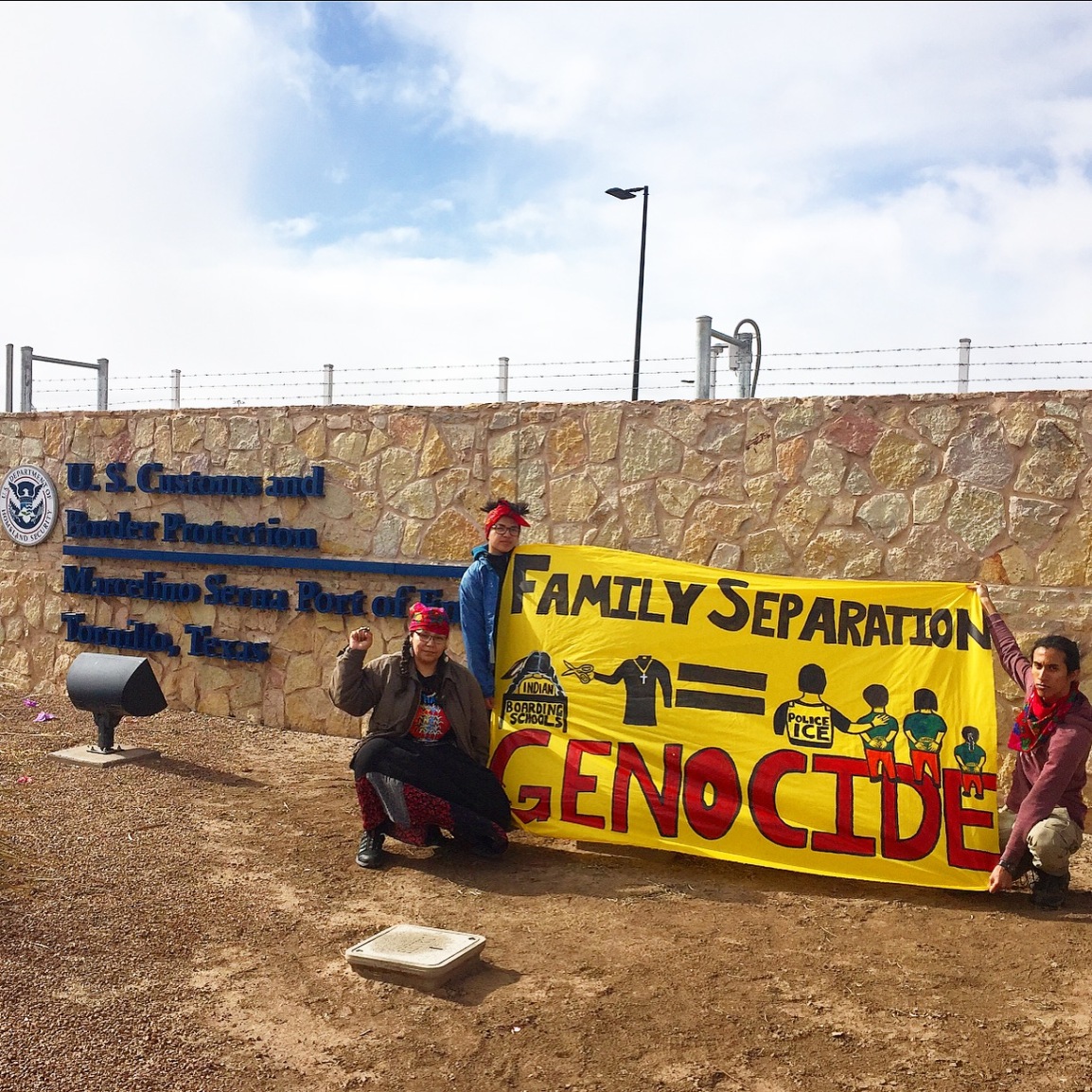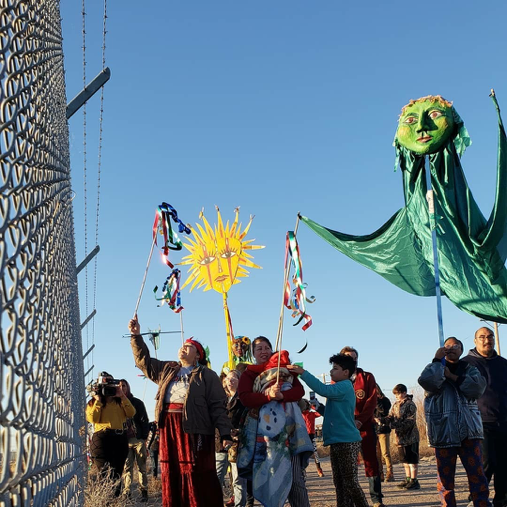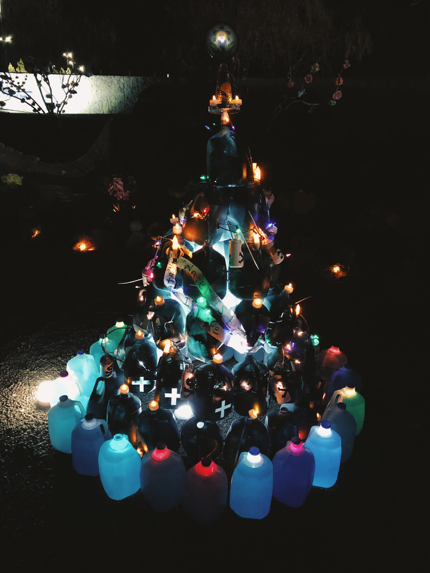
by Hope Alvarado, N. Lira-Pérez, and Nicolás Cruz
On December 26, 2018, as part of a Red Nation delegation, we traveled to Tornillo, Texas where nearly 3,000 migrant children are being detained. After driving past cotton fields and rows of pecan trees, we finally arrived at an unused toll plaza where we drove straight through. Ahead of us was one of several walls, guarding the entrance to the Tornillo-Guadalupe port of entry. When we pulled up we saw two RVs, a couple of tents in a small dirt field along the wall, and half a dozen people milling about and huddling together in the cold. Beyond the wall, we made out a bigger wall: the fence spanning the U.S.-Mexico border along the Rio Grande. Between this wall and the first, we weren’t sure what we were looking at. We would later learn that the large white tents and towering floodlights were indeed part of the detention camp holding the hundreds of youth who had either traveled across the border alone or who were separated from their families upon doing so.
The Tornillo Occupation camp seemed oddly small, and when we entered the RV looking for our contact, an organizer from St. Louis, a Ferguson Freedom Fighter who was part of a larger delegation. The contact told us that two nights prior, on Christmas Eve, Immigration and Customs Enforcement (ICE) dumped around 200 people—including families with children—at the Greyhound bus station in El Paso, Texas. They were left there with no food or water, hardly any clothes or jackets; some people were severely sick and had no directions as to where to go next. Many of the organizers who came for the protest encampment hurried to El Paso, which is 40 minutes north of Tornillo, to provide immediate aid. Entire motels were rented out, becoming both housing and central locations for intake as well as food and clothing distribution. Local organizations, such as the Detained Migrant Solidarity Committee, mobilized resources to buy bus tickets for migrants to go to where their family members who are already in the US awaited them. Since that first day, ICE dropped off an average of 300 people, including children, every day at seemingly random places in El Paso, including a park late at night, various motels, and bus stations.
Once we arrived, we were updated about the situation and the change of plans. The organizers shared that there was a need for Spanish speakers to translate and help shuttle families to the bus station as well as provide them with jackets, clothes, herbal remedies, and food. We glanced at one another not knowing what role we would be step into. There was also a call for natural healers since many of the migrants mistrusted western medicine from their experiences interacting with clinics and ICE personnel. Since two of us spoke Spanish and all knew herbal remedies, we decided to make our way to El Paso. Adults and children were tired, sick, and sore from both crossing the militarized border zone and being held in ICE hieleras, or ice boxes—large holding cells that are used to detain many families at a time. Many of the migrants reported having to sleep on concrete floors with only aluminum foil-like Mylar blankets, sometimes even having their babies’ blankets removed from them.
At one of the motels-turned-into-emergency shelter, we were tasked with finding migrants waiting for their bus later that evening, providing them jackets and shoes from the “Free Store” of donated goods, and collecting bags of food, water, and snacks for their days-long bus rides to places like Tennessee, Florida, Delaware, and New Jersey where they had relatives waiting. Most spoke no English and some even little Spanish, but most spoke a range of Indigenous languages; it was difficult to find translators for each one. Instead, we had to make do with the lingua franca,as one organizer put it: the colonizer’s Spanish.
Most of the families who had been dumped by ICE, from what we could tell, were asylum seekers who had surrendered themselves to Border Patrol at a port of entry, as is required for asylum. The Trump administration has tried to circumvent asylum law by claiming that asylum seekers must apply while in Mexico or their home country, preventing people arriving at the border from doing so. Yet, the majority of asylum seekers who have reached the border have been held in private detention centers like the Tornillo migrant youth camp or in family detention centers run by private prison companies. With the federal government shutdown being used as a bargaining chip for Trump’s border wall, there were rumors that hundreds of migrants were released by ICE because of a lack of Department of Homeland Security (DHS) funding to detain them. Whatever the reason, dumping hundreds of people in different locations around El Paso in near freezing temperatures forced local organizers to mobilize and redirect their energy away from the Tornillo Occupation and other efforts they were engaged in.
We drove back to Tornillo after a day of translating, shuttling families to the bus, and preparing food and herbal remedies. On the way, one of the core St. Louis organizers who had planned the occupation explained that this movement had two parts: Resist and Assist. What we did that day, she explained, was the assist portion: we respond to the needs of our communities, to provide the basic necessities of migrant families who have been abandoned by ICE and who need to find their ways to their relatives who are waiting for them. But back in Tornillo, we were going to be enacting resistance: building people power to confront the injustice of migrant detention (and all detention) and to contest the power of the settler state to detain, deport, and kill people fleeing violence; the structural poverty caused by global capitalism; and the effects of climate change. When we arrived at camp, word had spread that The Red Nation had answered the organizers’ call to action. People were elated to have an organization focused on Native Liberation join the struggle for migrant justice. We were all excited to make connections between our movements. As we became acquainted with the camp and its organizers, we watched the encampment grow as people arrived to show the youth being imprisoned, just beyond the barbed wire fences, that they were not alone.
…

We awoke most mornings to the sound of at least several dozen private coach buses rolling by loudly into the Port of Entry gate, just feet away from our encampment. Though the windows were darkly tinted, we knew that these buses carried in the hundreds of staff members whose jobs were to detain, feed, and supervise the nearly 3,000 migrant youth inside the camp. Every morning and evening during the shift change, buses arrived and left. The employees were bused in from hotels in nearby Fabens and El Paso. Many of the them had their phones and camera equipment checked in so that they couldn’t document the violence and abuses occurring inside. None of the 2,100 total staffers have undergone fingerprinting or background checks—a requirement waived by the Trump administration. In fact, we were told that the workers were hired on the condition that they not put it on their résumés in order to hide any connection to the Department of Health and Human Services and the private religious nonprofit contracted to run the camp, Baptist Child & Family Services (BCFS). Organizers from the occupation carried out several actions involving staff members, handing them whistles and flyers saying, “Whistleblowers save lives” and a number to an anonymous tip line. So far to our knowledge, none have called.
The first action we partook in was on the morning after we arrived: a meditation walk around the fence of the detention camp, along the towering fence that borders much of the New Mexico and Southwestern Texas borders. As we walked, we were followed by private security cars hired by BCFS as well as by DHS officers. When we got to the back of the camp we came across dozens of soccer balls that had been kicked over the barbed wire fence and net by the children playing in the astro turf soccer field where they were escorted to a few times a day. Standing up on the rail guard leading to the gate in the border fence, we were able to see a line of young children being marched by two staff members towards the soccer field. “¡No están solos! You are not alone!” we shouted as the children responded in waves and cheers. The staff members immediately turned their back to us and ordered the children away from the soccer field. We were worried that being there prevented the children from having their time to play outside. Later learned that they are merely redirected to a field on the opposite side of the camp. Everyone present carried the recovered soccer balls, volleyballs, and footballs back to camp to write messages of support before throwing them back over the fence.
Back at the encampment, we gathered with activists who had come from Minnesota, Dallas, El Paso and California, as well as the large delegation of St. Louis organizers. We learned about what the organizers had done so far, such as setting up an ofrenda, or altar, alongside the road leading to the port of entry and detention camp, and putting up the thousands of donated tissue paper flowers to represent the children detained inside the camp. The first ofrenda had blown away in the wind the day before we arrived and we were asked to help reassemble it in a different location closer to our camp.
By mid-morning, two DHS officers and two staff members drove out of the gate and began digging holes to put up signs, which stated that anyone beyond that point was subject to search, that firearms were prohibited, and that everyone beyond the sign had to provide identification.Our camp was in the middle of the area designated “subject to search.” The officers told us that we could not camp out past that line, which was a demarcation between federal and county land and that we would have to remove the ofrenda. Everyone protested loudly, urging the two staff members to walk away and to change their line of work. “What would your abuela (your grandma) think of what you’re doing?” one organizer asked the man digging the hole for the sign. He eventually walked away, telling the officers, “I can’t work under these conditions.”
In the process of the two staffers digging and setting the signposts, an activist as well as a trans woman who’d come with the St. Louis delegation was targeted by the federal officers for arrest, handcuffing her on one arm. Immediately, members of her delegation as well as other organizers jumped on top of her, creating a “puppy pile” that would ultimately prevent the police from arresting her. To shouts of “Walk away!” the police officers released their grip and handcuff, and consulted with the plainclothes DHS special agent who pulled up in an unmarked car. The activist who was targeted was instead given a citation. The police informed us they’d be back the next morning and told us that our tents and the ofrenda had to be removed from federal property.
Though shaken by the near-arrest of one of our own, the successful resistance and solidarity against police attack was inspiring. To see both the immediate solidarity of people who threw themselves between the police and their target as well as those of us who stood recording, chanting, or negotiating a release with the police demonstrate the power of solidarity and relationships. From that day, the police (both federal and county) seemed to give the encampment more space, though they increased their surveillance. Throughout the nights, there were two different occasions where police cars, fire trucks, and ambulances passed through the toll tower into the Tornillo Detention Facility. But there were never any news reports about any incidents at the facility. Many of the Tornillo occupiers participating in the assist actions in El Paso were told about some of the violent and inhumane conditions that they experienced. Many of the migrants shared information that the youth who were in the ice boxes with them would become very sick and/or would pass away due to the conditions of the camp, and the detention facilities would quickly take and “dispose” of the bodies. The migrants shared that the detention facilities were not reporting all the deaths happening inside. We were told that had they known these deadly conditions awaited them, people would rather go back to their homelands than in the Ice boxes.
Later that afternoon, we gathered banners, large puppets, and a stilt walker adorned with giant butterfly wings. We marched along the barbed wire fence surrounding the detention camp. We saw a group of children playing soccer in a different field than the one we saw earlier in the day, and we chanted loud enough for them to hear us. Many stopped to wave and some even shouted back at us. Like our messages written on the collected soccer balls, we wanted to let the children know that they were not alone nor forgotten and that people outside the detention camp were fighting for them.
After we delivered the soccer balls to the field near the border fence, the next morning we were approached by nearly a dozen deputy sheriffs and vehicles blocking our return to our encampment. We quickly lined up in three rows, with the most vulnerable to police brutality on the inside, and marched past the police as we sang. They stepped aside. Officers and security inside of the inner fence to the detention facility took pictures and recorded us. When we got back to camp, members of The Red Nation suggested we have a debrief to discuss our varied experiences and intentions of participating in direct action. We then decided that we needed to have a direct-action workshop so that everyone was on the same page.
Collaborating with activists from the Ferguson uprising, local lead organizers, and pipeline fighters, The Red Nation members helped facilitate a workshop that covered protocols for direct actions, interacting with police, the arrest process, and other tactics. Through collective knowledge and skill sharing, we worked to develop trust and prepared for actions for the next days or even weeks of camp. The day after we left, the organizers who remained at the camp created a blockade blocking employee buses during the shift change. They set up jugs of water that had been collected by No More Deaths in the desert along the border—some of which were slashed by Border Patrol and white supremacist vigilantes—along with a Christmas tree made of water jugs adorned with the images of the latest two children who died in ICE custody or shortly after their release: Jakelin and Felipe. They were able to stop the buses of employees for more than an hour and force them to turn around without any activists being arrested.

The issue of water—in this case, the withholding of water and the criminalization of those who provide water to migrants—stood out to us as a powerful and profound connection between seemingly distinct movements. As Water Protectors, members of The Red Nation know and act on the fact that “Water is Life” or “Agua es Vida.” Yet, we see the settler nation-state killing refugees by giving them dirty, contaminated, or insufficient water while in custody or preventing them from accessing water left for their survival. In order for Indigenous sovereignty to be in conversation with refugee and migrant struggles, we must remember that our refugees and migrant relatives will remain under threat as long as the settler state continues to dictate who can enter and who can be deported, detained, and killed on stolen land. This is why it is necessary for Indigenous peoples to contest the state’s power by supporting our relatives who are fleeing their homelands due to US policies, which create the violence people are fleeing in the first place. We left the Tornillo encampment with the intention of spreading a national call for people to travel to Tornillo, Texas to assist where needed and resist the ongoing imprisonment of thousands of children whose only crime is crossing an imperial border.
But Tornillo is not the only detention camp. There are many camps, shelters, and prisons all over the country. Many of the children held in Tornillo are being transferred to an even larger facility in Homestead, Florida. There was talk of closing Tornillo’s detention camp, but organizers on the ground have continued to see children being bussed in and out even as news outlets report that it has been completely shut down. The call is still being made, and people are needed to resist migrant detention facilities in Tornillo, Fabens, El Paso and everywhere else it is occurring. There is still an increasing need for people who speak Spanish or Indigenous Central American languages to travel to El Paso to provide support for the hundreds of asylum seekers still being dumped on the streets every day by ICE. For more information please reach out to Annunciation House, which is one of the organizations spearheading the efforts to provide housing, food, clothing, and transportation for the released families.
Stay tuned for The Red Nation’s continued involvement in Tornillo, with the possibility of sending a delegation of community members from Albuquerque, Gallup, Santa Fe and other parts of New Mexico down to Texas. We will publish a follow up article focusing on what we saw framed by an analysis of border imperialism—a framework put forth by activist-scholar Harsha Walia in the book Undoing Border Imperialism. Solidarity =means making connections across struggles and settler borders to create paths to liberation for all.
#AbolishICE #AbolishBorderImperialism #NoDeportationsOnStolenLand #NoBansOnStolenLands
Subscribe: